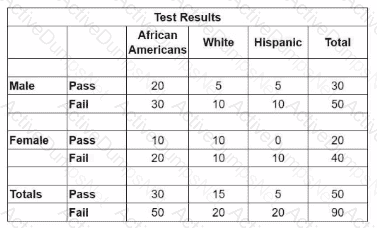An organization stays abreast of major changes in related industries through:
When an organization engages in reckless discrimination and fails to act in good faith, a court will typically order:
A summary of an organization's financial investment in employees is demonstrated through a(n):
Which of the following is an unstructured learning approach to stay updated on HR and business trends?
Which of the following is a quantitative measure of an HR department’s performance?
A nonexempt employee, who is a reservist in the US Army, is called to active duty with an assignment for six months of service. When the assignment ends early, the employee asks to return to work after five months of leave. What are the requirements for reemployment?
After receiving a large order, the shipping supervisor of a unionized manufacturing plant informs the crew that an overtime shift will be scheduled for the following Saturday. Three of the employees strongly object but do not provide acceptable excuses for not working the extra shift. On Saturday, none of the three employees report to work and the supervisor is forced to call out replacement employees from other departments. On the following Monday, as part of an investigation to determine if disciplinary action is called for, the supervisor instructs each of the employees to report alone to the office immediately after their shifts. The supervisor's intention is to question them about their failure to report for the overtime shift as required.
The employer’s policy provides a four-level, progressive disciplinary system. If disciplinary action is appropriate, the factor that has the most direct bearing on the level of discipline enforced is each employee’s:
A summary of an organization's testing results is presented. Each applicant who passes the test is hired.

To determine the minimal selection rate for each protected group, the highest selection rate should be multiplied by:
Which of the following is a measure of the variability of ratings in a selection instrument?
An organization is implementing a new training curriculum to ensure employee competency in specific areas. While designing the curriculum for a safety class, it is determined that some content should be modeled. An example of this is:
The best measure of an outplacement program’s success is the:
What is the best tool to use when creating a list of skills for a specific role?
A receptionist has a need for intermittent leave of absence. Which of the following staffing methods would be most cost-effective to fill the vacancy?
Which of the following is the best way in which auditory learning can be achieved?
When evaluating the credibility of a witness during an internal investigation, it is necessary to consider the witness's:
Which of the following is the most common way the security of personnel files is breached?
When union activity occurs in an organization, which is the best action for a supervisor to take?
The most important consideration when gathering demographic data as part of an employee survey is to avoid questions:
An employer can regulate the off-duty activities of an employee when the conduct is:
For purposes of succession planning, which tool is best to evaluate an employee's current performance?
A supervisor wants to terminate an employee with 10 years of service due to excessive absences. The employee has certification for intermittent leave under the Family and Medical Leave Act (FMLA) for a chronic condition. The certification specifies an anticipated need for leave 1–3 days per month. The employee averages 6 days off per month and is close to exhausting the protected leave bank. A coworker provided to HR printouts of the employee’s social media page with photos of the employee on vacation while reporting time as protected leave.
Based on the difference between the anticipated need and actual leave taken, the employer should:
During the military leave, the organization may:
Which organizational structure groups its employees according to the brands they support?
After receiving a large order, the shipping supervisor of a unionized manufacturing plant informs the crew that an overtime shift will be scheduled for the following Saturday. Three of the employees strongly object but do not provide acceptable excuses for not working the extra shift. On Saturday, none of the three employees report to work and the supervisor is forced to call out replacement employees from other departments. On the following Monday, as part of an investigation to determine if disciplinary action is called for, the supervisor instructs each of the employees to report alone to the office immediately after their shifts. The supervisor’s intention is to question them about their failure to report for the overtime shift as required.
The supervisor would be engaging in what could be deemed an unfair labor practice by failing to:
A primary benefit of an effective onboarding program is that it:
The primary advantage to self-insurance is that the employer:
Employees must be taxed on employer-paid premiums of life insurance over what amount?
For an HR professional to become a strategic business partner, it is most critical to:
(Enter the answer as a numeric value.)
The annual yield ratio is 75%. If an organization interviews 16 candidates, it hires __________ of them.
What are the most important factors when developing a diversity, equity, and inclusion (DEI) strategy? (Select TWO options.)
A total rewards approach works successfully when:
Which of the following recruitment sources should be eliminated as the most significant cost-saving measure?
An employer can reduce the risk associated with a lost or stolen mobile device by:
An organization is implementing a new training curriculum to ensure employee competency in specific areas. The long-term goal is to turn the curriculum into an internal certification program that will be used as part of career development and succession planning. A Senior IT Technician files a grievance with the union, claiming that the entire program is unfair since the technician is at the highest level of the position. Which of the following scenarios could result in an unfair labor practice?